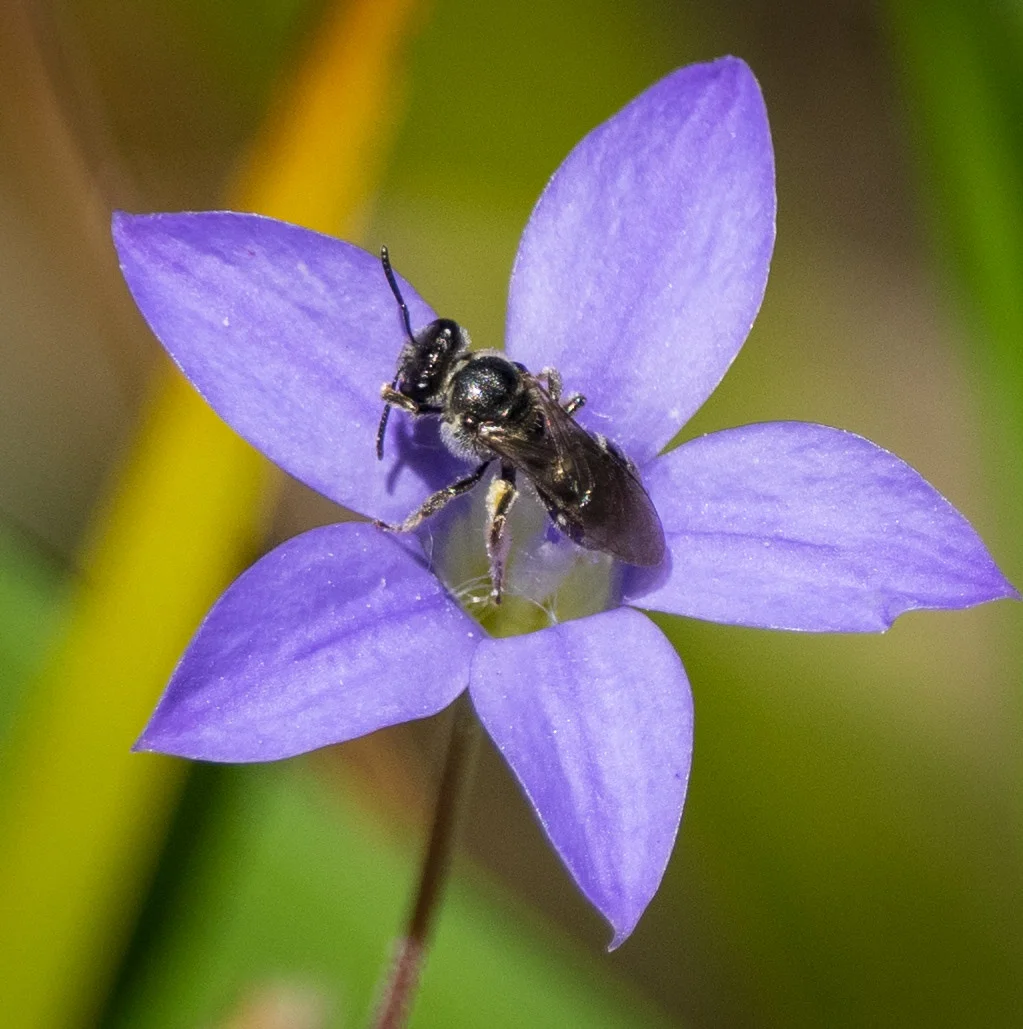
green longhorn beetle
Beetles with antennae like this are readily recognised as longhorn beetles. This is the first green one we've seen.
Rhytiphora nigrovirens
Order: Coleoptera; Family: Cerambycidae

green longhorn beetle
The insect is beautifully camouflaged. And there is something endearing and puppy-like in the way it is hunkered, 'nose-down', on its perch.
Rhytiphora nigrovirens
Order: Coleoptera; Family: Cerambycidae

Belid Weevil
Weevils come in all shapes and sizes ... and cover several families. Unlike many other weevils, adult Belid Weevils usually feed on pollen. This rather attractive insect was simply resting on a Juncus stem in the early morning.
Rhinotia sp.
Order: Coleoptera; Family: Belidae (primitive weevils)

Eucalypt Psyllid (male)
The psyllid Glycaspsis seriata is an important insect in the forest ecosystem. Its nymphs extract large amounts of sugars from eucalypt leaves and are in turn a key food source for many birds.
Order: Hemiptera; Family: Psyllidae

Tip-wilting bug
Most of the truly bug-like bugs we see are quite small, so this one really caught our attention. It was probably 20mm long (although I didn't check, exactly). Bugs in this family feed on young plant growth and can cause it to rapidly wilt.
Amorbus sp.
Order: Hemiptera; Family: Coreidae

Milk-vine Bug
Early morning, before the Summer's day heats up, a walk through the low foliage is always rewarding. The leaves are beaded with moisture, and the insects that will later become active or wary are just starting to wake.
Oncopeltus sordidus
Order: Hemiptera; Family: Lygaeidae

Hoppers
This hasn't been a particularly 'big' season for grasshoppers. Some years, February sees the grasses awash with nymphs and adults, small and large. There are some, however.
Order: Orthoptera; Family: Acrididae

Slug-like caterpillar
There is a family of moths that are often called 'Cup moths', because their pupae look like open flasks or cups atop Eucalyptus leaves. But they are also called 'Slug moths' - because their colourful and well-defended caterpillars move more like slugs that typical caterpillars.
Order: Lepidoptera; Family: Limacodidae

Gum Leaf Skeletoniser
The larvae of this moth mine the cells in eucalypt leaves, leaving the veins behind.
Uraba lugens
Order: Lepidoptera; Family: Nolidae

Eastern Grey Kangaroos
This large male has been generally making a nuisance of himself for a week or more. He never lets the female far from his sight. Once she is no longer in oestrus, we rarely see the males and females together.

Double-spotted Cicada
The explosion of Masked Devils that we had in early Summer is long over, but we are still seeing (and hearing) some other cicada species.
Galanga labeculata
Order: Hemiptera; Family: Cicadidae

Robber Fly
This is quite a small robber fly. The slender body and extremely long legs distinguish it from the hundreds of other species of Robber Fly.
Leptogaster sp.
Order: Diptera; Family: Asilidae; sub-family: Leptogastrinae

Wasp season
February is definitely 'wasp-month' in the forest.
Order: Hymenoptera; Family: tbc

a parasite of beetle larvae
Braconid wasps are often strikingly coloured in various patterns of black, orange, yellow and white. Despite this, they are very difficult to identify beyond sub-family. These wasps lay eggs into wood-boring beetle larvae. I suspect this female was searching for such grubs.
Order: Hymenoptera; Family: Braconidae; sub-family: Braconinae

another new wasp
I'm recording any new species I sight - the task of trying to sort out just what it is will come later.
Update! It's called a Velvet Ant, although it is considered a wasp.
Order: Hymenoptera; Family: Mutillidae

Digger wasp
Water is a great place for wasp spotting. They are regularly visiting the pond surface to drink - and just occasionally they lose their footing. This wasp survived a near drowning - and the jaws of voracious diving beetles - to clamber up this stem to dry out.
Sphex sp. (I think)
Order: Hymenoptera; Family: Sphecidae; sub-family: Sphecinae

More bees
Despite the distraction of the wasps, I'm still keenly bee-watching. This small bee may be a Lassioglossum sp, here grooming and packaging pollen from a Blue Bell (Wahlengbergia) flower.
Order: Hymenoptera: Family: Halictidae

Geebung bees are still about
Having become familiar with this Geebung specialist, I see Leioproctus bees whenever I check out the flowering Persoonia bushes.
Order: Hymenoptera; Family: Colletidae

Baby Jacky
There are suddenly many tiny Jacky Lizards about. This one is only about 50mm long. Perhaps this explains why we are not seeing quite as many grasshoppers as usual ... ?
Amphibolurus muricatus

Margin-winged Stick-insect
A true master of camouflage.
Ctenomorpha marginipennis
Order: Phasmatodea

Splendid Ochre
Trapezites symmomus
Order: Lepidoptera; Family: Hesperidae





















